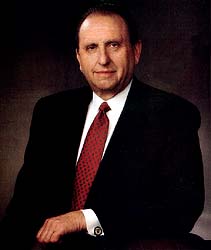The President of The Church of Jesus Christ of Latter-day Saints, often mistakenly called the “Mormon Church,” is the highest priesthood office in the Church. Members of the Church of Jesus Christ also sustain the President as prophet, seer, and revelator, and God designates him as the only person authorized to receive revelation for the Church as a whole. (See Doctrine and Covenants 28:2.) He serves in this calling until his death.
History of the Selection of President
Sixteen men have served as President of the Church. Each served as President until his death. After the assassination of the first President, Joseph Smith, some Latter-day Saints thought that his son or his counselor should be appointed President. However, the Quorum of the Twelve Apostles, the second highest governing body in the Church, knew that the Apostles held the keys of the priesthood and that the Senior Apostle, also known as President of the Quorum of the Twelve Apostles, should preside. Brigham Young led the Church for over three years in this capacity. He was then sustained as President of the Church. Second and third church presidents John Taylor and Wilford Woodruff followed the same pattern. All other Presidents of the Church began serving after a much shorter period of time after the death of the previous President.
Process for Appointing the President
 Latter-day Saints believe that the Lord Jesus Christ is the head of the Church and that He has established an orderly method for changing the leadership. The First Presidency of the Church of Jesus Christ consists of the President and his two counselors. Each is typically selected from the Quorum of the Twelve Apostles. When the President of the Church dies, the First Presidency is dissolved and the counselors return to their places in the Quorum of the Twelve according to their seniority, or the dates of their ordinations as Apostles. The Quorum of the Twelve, led by the Senior Apostle, or President of the Twelve, then preside over the Church until a new President and First Presidency are chosen.
Latter-day Saints believe that the Lord Jesus Christ is the head of the Church and that He has established an orderly method for changing the leadership. The First Presidency of the Church of Jesus Christ consists of the President and his two counselors. Each is typically selected from the Quorum of the Twelve Apostles. When the President of the Church dies, the First Presidency is dissolved and the counselors return to their places in the Quorum of the Twelve according to their seniority, or the dates of their ordinations as Apostles. The Quorum of the Twelve, led by the Senior Apostle, or President of the Twelve, then preside over the Church until a new President and First Presidency are chosen.
Upon the death of the President, the Twelve Apostles meet to prayerfully seek the will of the Lord in selecting the next President. This prayerful selection follows the pattern explained in the Church’s fifth Article of Faith: “We believe that a man must be called of God, by prophecy, and by the laying on of hands by those who are in authority.” The new President is nominated by unanimous vote. The President then selects his two counselors to form the First Presidency, who are also approved by the Twelve Apostles. Any vacancies in the Quorum of the Twelve Apostles are also filled by revelation. At the next general conference of the church (held semiannually), each member of the Church is given the opportunity to sustain or oppose these men.
Each of the Apostles holds the keys of the priesthood to be the President of the Church because of his ordination as an Apostle, but only the Apostle selected as President exercises those keys. This means that the president “holds the power and authority to govern and direct all of the Lord’s affairs on earth in the church.”
Mormons believe that the Lord knows all the men who will serve as President of His Church and that He calls them to be Apostles. When the time comes for a new President to be selected, he is already serving as Senior Apostle. Twelfth President of the Church, Spencer W. Kimball, explained, “Since the death of his servants is in the power and control of the Lord, he permits to come to the first place only the one who is destined to take that leadership. Death and life become the controlling factors.” [1]
Callings in the Church of Jesus Christ
 Latter-day Saints are called to serve in the Church of Jesus Christ continually. [2] Through prayer, priesthood leaders seek the will of the Lord in their selection of members to serve. Each member serving is accepted by other members of the Church through a sustaining vote, also known as Common Consent (Doctrine and Covenants 26:2). Mormons are not obligated or constrained to accept the responsibility and can ask to be released from their calling at any time for any reason. Most members of the Church of Jesus Christ accept a variety of callings to serve in the Church during their lifetimes and serve until their priesthood leaders prayerfully decide to release them. The length of service time varies widely. Only those men called to serve in the Quorum of the Twelve Apostles are expected to serve for life and are not released because of failing health or advanced age. The President of the Church serves under the same expectation, and each of the men serving in that calling have continued to serve despite poor health. For example, Thirteenth President, Ezra Taft Benson, suffered poor health in the last years of his life and was rarely able to leave his home. In the general conference of the Church held the month prior to President Benson’s death, Gordon B. Hinckley, who was then serving as the First Counselor in the First Presidency, spoke directly about President Benson’s health and reaffirmed the governing roles of the First Presidency and the Quorum of the Twelve:
Latter-day Saints are called to serve in the Church of Jesus Christ continually. [2] Through prayer, priesthood leaders seek the will of the Lord in their selection of members to serve. Each member serving is accepted by other members of the Church through a sustaining vote, also known as Common Consent (Doctrine and Covenants 26:2). Mormons are not obligated or constrained to accept the responsibility and can ask to be released from their calling at any time for any reason. Most members of the Church of Jesus Christ accept a variety of callings to serve in the Church during their lifetimes and serve until their priesthood leaders prayerfully decide to release them. The length of service time varies widely. Only those men called to serve in the Quorum of the Twelve Apostles are expected to serve for life and are not released because of failing health or advanced age. The President of the Church serves under the same expectation, and each of the men serving in that calling have continued to serve despite poor health. For example, Thirteenth President, Ezra Taft Benson, suffered poor health in the last years of his life and was rarely able to leave his home. In the general conference of the Church held the month prior to President Benson’s death, Gordon B. Hinckley, who was then serving as the First Counselor in the First Presidency, spoke directly about President Benson’s health and reaffirmed the governing roles of the First Presidency and the Quorum of the Twelve:
“The President of the Church holds the authority to exercise all of the keys of the priesthood at any given time. He may delegate, and in the present instance has delegated, to his Counselors and to those of the Twelve the exercise of various of those keys.
“This brings me to a matter of which I have spoken before from this pulpit. I do so again because of what some are writing and saying incident to the condition of President Benson’s health.
“People throughout the Church are naturally anxious to know of the President’s condition. President Benson is now in his ninety-fifth year. As we have previously said from this and other pulpits, he suffers seriously from the effects of age and illness and has been unable to fulfill important duties of his sacred office. This is not a situation without precedent. Other Presidents of the Church have also been ill or unable to function fully in the closing months or years of their lives. It is possible that this will happen again in the future.
“The principles and procedures which the Lord has put in place for the governance of His church make provision for any such circumstance. It is important . . . that there be no doubts or concerns about the governance of the Church and the exercise of the prophetic gifts, including the right to inspiration and revelation in administering the affairs and program of the Church, when the President may be ill or is not able to function fully.
“The First Presidency and the Council of the Twelve Apostles, called and ordained to hold the keys of the priesthood, have the authority and responsibility to govern the Church, to administer its ordinances, to expound its doctrine, and to establish and maintain its practices. Each man who is ordained an Apostle and sustained a member of the Council of the Twelve is sustained as a prophet, seer, and revelator. . . .
“God is at the helm. . . . Jesus Christ is our Redeemer. He is the head of this church. He makes known His will and will continue to make known His will concerning it. Joseph Smith was a prophet through whom all the keys of the priesthood under which we operate were restored in this dispensation of the fullness of times. Each man who has succeeded him as President of the Church has been a prophet. We have a prophet today. He may not be able to speak to us as he once did. He need not. . . . When the Lord calls him home, there will be another to take his place”(Gordon B. Hinckley, “God Is at the Helm,” Ensign, May 1994).
Can the President of the Church of Jesus Christ resign? Yes. But no President has ever resigned or been released. The order of governance for the Church enables him to continue to serve until his death.
(See also: The Presidents of the Church, teacher’s manual (Salt Lake City: Church of Jesus Christ of Latter-day Saints, 1996).
This article was written by Paula Hicken, a member of The Church of Jesus Christ of Latter-day Saints.
Additional Resources:
Everything About the Church of Jesus Christ
http://youtu.be/6p-s00HsrnM?t=7m41s